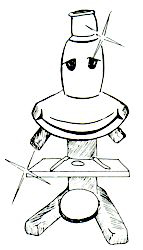Make sure that you only clean your microscope lenses when they are dirty and use the proper materials! You can purchase a microscope cleaning kit here.
If your objective lenses are dirty, you can remove build-up with lens paper dipped in a very weak ammonia solution. Place one eye dropper full of household ammonia in 1/2 cup of water.
If you have any sticky substances on your objectives such as balsam, oily materials or paraffin, this should be removed with xylol.
To clean microscope eyepiece lenses, breathe condensation onto them and then wipe them with lens tissue. Kim-wipes are made by Kleenex and generally will work well. For stubborn spots, wipe the surface with tissue moistened with 95% alcohol. Wipe the lens dry with a dry tissue.
If you see black specks when you look through the microscope, turn the eyepiece lens to see if the specks also turn. If so, the dust is on either the inside or outside eyepiece lens. Clean the eyepiece lens with lens tissue. If the spots remain, remove the eyepiece lens and brush the inside of the eyepiece lens with a camel hair brush or lens paper.
DO NOT USE cloth, ordinary paper or fingers! Make sure that you use only special lens cleaning tissues!
Periodically inspect the power cords and plugs for safety and have a supply of replacement bulbs available.
Professional cleaning and adjusting should be performed whenever necessary at an optical shop specializing in microscopes. Usually the microscope manufacturer can recommend a qualified professional that services their microscopes and will not alter the warranty.
When microscopes are not in use, they should be covered with plastic and stored in a safe area where they won't get knocked over or stolen.
Keeping a clean microscope will ensure that you will get many years of quality use out of your microscope!

